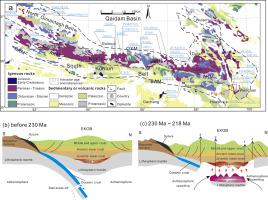当前位置:
X-MOL 学术
›
Gondwana Res.
›
论文详情
Our official English website, www.x-mol.net, welcomes your
feedback! (Note: you will need to create a separate account there.)
Petrogenesis of Late Triassic mafic enclaves and host granodiorite in the Eastern Kunlun Orogenic Belt, China: Implications for the reworking of juvenile crust by delamination-induced asthenosphere upwelling
Gondwana Research ( IF 7.2 ) Pub Date : 2020-08-01 , DOI: 10.1016/j.gr.2020.02.012 Hongzhi Zhou , Daohan Zhang , Junhao Wei , Dazhao Wang , M. Santosh , Wenjie Shi , Jiajie Chen , Xu Zhao
Gondwana Research ( IF 7.2 ) Pub Date : 2020-08-01 , DOI: 10.1016/j.gr.2020.02.012 Hongzhi Zhou , Daohan Zhang , Junhao Wei , Dazhao Wang , M. Santosh , Wenjie Shi , Jiajie Chen , Xu Zhao

|
Abstract Late Triassic granitoids containing abundant mafic microgranular enclaves (MMEs) occur widely in the Eastern Kunlun Orogenic Belt (EKOB). In this work, we present mineral chemistry, zircon U-Pb ages and L-Hf isotopes, whole-rock chemistry and S-Nd isotope compositions of the MMEs and host granodiorite from the Huda pluton in the Elashan area within the easternmost domain of the EKOB. These rocks contain inherited (Meso- to Neoproterozoic) and xenocrystic (ca. 240 Ma) zircon grains that yield apparent older ages, whereas the magmatic zircons from MMEs and granodiorite yield similar weighted mean ages around 224 Ma, which are interpreted as their crystallization ages. The MMEs have low SiO2 but high TiO2, TFe2O3, CaO, MgO and MnO concentrations with relatively high Mg# values (48–54) and 100MnO/(MnO + MgO + TFe2O3) ratios (1.2–1.6). They display identical Sr-Nd-Hf isotope compositions to the host granite. Combined with petrological evidence, we suggest that the MMEs are cognate cumulates that formed by pressure quenching during the late stage of magma evolution from the same parental magma of the host granodiorite, rather than a magma mixing origin. The granodiorite is calc-alkaline to high-K calc-alkaline, metaluminous I-type granite. They show relatively low SiO2 and MnO, but high MgO, Al2O3, CaO and TFe2O3 contents with Mg# values of 45–50. They are enriched in light rare earth elements (LREEs) and large ion lithophile elements (LILEs), such as Rb, Th, K and Pb, and are depleted in P and high field strength elements (HFSE) including Nb, Ta and Ti. These rocks display slightly negative Eu anomalies and low Sr/Y and La/Yb ratios. Together with the rim-ward chemically evolved nature of some phenocrysts, the comparatively high initial Sr isotope (0.70888–0.70912), low whole-rock eNd(t) (−5.6 to −6.0) and zircon eHf(t) (−3.3 to −0.1) values, and low Nb/Th (0.11–0.26) and Ta/U (0.53–0.68) ratios, we suggest that the granodiorite magma was sourced from the lower crust. Considering their comparatively young two-stage Nd and Hf model ages (1.42–1.49 Ga and 1.13–1.42 Ga, respectively) and same trace element character with the juvenile crust beneath the EKOB, we interpret the juvenile lower crust as the dominant source rocks for the granodiorite. Based on our data and regional geological evidence, we suggest that the partial melting of juvenile crust resulted from delamination-related asthenosphere mantle upwelling. The latter process resulted in extensive melting of the lower crust, producing a major Late Triassic magmatic flare-up event in the EKOB.
更新日期:2020-08-01











































 京公网安备 11010802027423号
京公网安备 11010802027423号